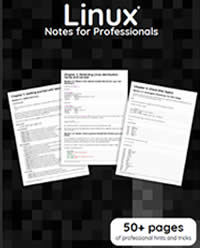SEARCH
Disclaimer: Authors have full rights over their works. Reproduction of any part of the content is prohibited without prior authorization.
BOOK LINUX NOTES FOR PROFESSIONALS
SUMMARY
-
Items Found: 103
- About 1
- Chapter 1: Getting started with GNU/Linux 2
- Section 11: Useful shortcuts 2
- Section 12: File Management Commands 3
- Section 13: Hello World 5
- Section 14: Basic Linux Utilities 5
- Section 15: Searching for files by patterns in name/contents 6
- Section 16: File Manipulation 7
- Section 17: File/Directory details 8
- Chapter 2: Detecting Linux distribution name and version 11
- Section 21: Detect what debian-based distribution you are working in 11
- Section 22: Detect what systemd-based distribution you are using 11
- Section 23: Detect what RHEL / CentOS / Fedora distribution you are working in 12
- Section 24: Uname - Print information about the current system 13
- Section 25: Detect basic information about your distro 13
- Section 26: Using GNU coreutils 13
- Section 27: Find your linux os (both debian & rpm) name and release number 14
- Chapter 3: Getting information on a running Linux kernel 15
- Section 31: Getting details of Linux kernel 15
- Chapter 4: Shell 16
- Section 41: Changing default shell 16
- Section 42: Basic Shell Utilities 17
- Section 43: Create Your Own Command Alias 18
- Section 44: Locate a file on your system 18
- Chapter 5: Check Disk Space 19
- Section 51: Investigate Directories For Disk Usage 19
- Section 52: Checking Disk Space 21
- Chapter 6: Getting System Information 23
- Section 61: Statistics about CPU, Memory, Network and Disk (I/O operations) 23
- Section 62: Using tools like lscpu and lshw 23
- Section 63: List Hardware 24
- Section 64: Find CPU model/speed information 25
- Section 65: Process monitoring and information gathering 26
- Chapter 7: ls command 28
- Section 71: Options for ls command 28
- Section 72: ls command with most used options 28
- Chapter 8: File Compression with tar command 30
- Section 81: Compress a folder 30
- Section 82: Extract a folder from an archive 30
- Section 83: List contents of an archive 30
- Section 84: List archive content 31
- Section 85: Compress and exclude one or multiple folder 31
- Section 86: Strip leading components 31
- Chapter 9: Services 32
- Section 91: List running service on Ubuntu 32
- Section 92: Systemd service management 32
- Chapter 10: Managing Services 33
- Section 101: Diagnosing a problem with a service 33
- Section 102: Starting and Stopping Services 33
- Section 103: Getting the status of a service 34
- Chapter 11: Modifying Users 35
- Section 111: Setting your own password 35
- Section 112: Setting another users password 35
- Section 113: Adding a user 35
- Section 114: Removing a user 35
- Section 115: Removing a user and its home folder 35
- Section 116: Listing groups the current user is in 35
- Section 117: Listing groups a user is in 35
- Chapter 12: LAMP Stack 36
- Section 121: Installing LAMP on Arch Linux 36
- Section 122: Installing LAMP on Ubuntu 37
- Section 123: Installing LAMP stack on CentoOS 38
- Chapter 13: tee command 40
- Section 131: Write output to stdout, and also to a file 40
- Section 132: Write output from the middle of a pipe chain to a file and pass it back to the pipe 40
- Section 133: write the output to multiple files 40
- Section 134: Instruct tee command to append to the file 40
- Chapter 14: Secure Shell (SSH) 42
- Section 141: Connecting to a remote server 42
- Section 142: Installing OpenSSH suite 42
- Section 143: Configuring an SSH server to accept connections 43
- Section 144: Passwordless connection (using a key pair) 43
- Section 145: Generate public and private key 43
- Section 146: Disable ssh service 43
- Chapter 15: SCP 45
- Section 151: Secure Copy 45
- Section 152: Basic Usage 45
- Chapter 16: GnuPG (GPG) 46
- Section 161: Exporting your public key 46
- Section 162: Create and use a GnuPG key quickly 46
- Chapter 17: Network Configuration 47
- Section 171: Local DNS resolution 47
- Section 172: Configure DNS servers for domain name resolution 47
- Section 173: See and manipulate routes 47
- Section 174: Configure a hostname for some other system on your network 48
- Section 175: Interface details 49
- Section 176: Adding IP to an interface 50
- Chapter 18: Midnight Commander 52
- Section 181: Midnight Commander function keys in browsing mode 52
- Section 182: Midnight Commander function keys in file editing mode 52
- Chapter 19: Change root (chroot) 54
- Section 191: Requirements 54
- Section 192: Manually changing root in a directory 54
- Section 193: Reasons to use chroot 55
- Chapter 20: Package Managers 56
- Section 201: How to update packages with the apt package manager 56
- Section 202: How to install a package with the pacman package manager 56
- Section 203: How to update packages with the pacman package manager 56
- Section 204: How to update packages with yum 57
- Chapter 21: Compiling the Linux kernel 58
- Section 211: Compilation of Linux Kernel on Ubuntu 58
- Credits 59
- You may also like


